STRATFORD, WEST HAM
| The name Stratford is thought to have come from the two words meaning 'Street' and 'Ford'. Until relatively recent times the Lea (or Lee) valley was a marshy area with deeper river channels of the rivers Lea and Channelsea running though it. Some quite recent maps still label the area where the Olympic Games will be held as Stratford Marsh. The Romans built a causeway for travellers and there was a ford at Old Ford. Romford Road follows the route of the Roman road to Colchester and at Stratford it met up with the road to Cambridge so that all travellers crossed by the ford. Stratford, therefore, was a major road junction. In the 12th century, it became important after Stratford Longthorne Abbey was built. | 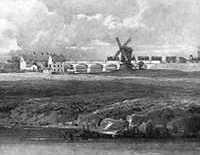 1839 view north from Stratford High Street showing Stratford railway viaduct and a windmill. |
PUT MOUSE OVER  TO READ NAME ~ CLICK FOR PHOTO & EXPLANATION.
TO READ NAME ~ CLICK FOR PHOTO & EXPLANATION.
CONTENTS |
||
| 1. Abbey Mills Pumping Station | 2. Beethoven & The Opera House | 3. "Bird and Monkey Fountain" |
| 4. Ye Olde Black Bull | 5. Boundary Marker | 6. Bow China Factory |
| 7. First Bus to Brighton | 8. The Old Court House | 9. The Old Dispensary |
| 10. King Edward VII | 11. Passmore Edwards | 12. The Grove Picture House |
| 13. Gurney Monument | 14. Gerard Manley Hopkins | 15. Ironmongers Stone |
| 16. Edith Kerrison | 17. "The Lavender Sellers" | 18. Millennium Mural |
| 19. "The Peace Sculpture" | 20. Protestant Martyrs Memorial | 21. Centrifugal Pump |
| 22. Railway Tree | 23. "Robert" | 24. St Francis |
| 25. "Science" | 26. William Shakespeare | 27. Stratford Common |
| 28. Stratford Frieze | 29. Stratford High Street Railings | 30. Stratford Langthorne Abbey |
| 31. "Stratford Market" | 32. Stratford Park | 33. Theatre Royal |
| 34. "Time Spiral" | 35. The Old Town Hall | 36. War Memorial Mystery |
| 37. West Ham Coat of Arms | 38. West Ham's First Casualties | 39. Workers' Memorial |
 |
Abbey Mills Pumping Station. |
|
This ornate building in Abbey Lane was built to house the giant pumps to move the contents of the main sewers housed in the raised bank nearby, and dates from 1868. Before that date, household sewerage often flowed down open ditches in the streets and emptied out in to the Thames at places near to where drinking water was extracted. This probably caused the Cholera epidemics of 1849 and 1854, which killed some 40,000 Londoners. The authorities were slow to deal with the problem, and not much was done till the "Great Stink" of 1858 when even the Houses of Parliament had to hang disinfected linen over the windows to counter the smell from the river. Joseph Bazalgette (1819 – 1891) was employed to build a London-wide sewerage system which is still in use today. He built this pumping station to raise the sewage about 36 feet from the low level of the East London sewers to the higher level beyond, which then carried the effluent by gravity to Barking and Thamesmead. The building, sometimes referred to as "The Cathedral of Sewage", originally contained four pumps which were steam-powered. When built, it had two large Moorish style chimneys, but these were pulled down in World War 2 because they were thought to provide a landmark for enemy bombers. The pumping station and the road got their name because the land in this area had belonged to the Abbey of Stratford Langthorne, which owned several mills. The building is occasionally open to the public, but one of the best views of the exterior is from the Greenway path. (See No. 1. on the MAP ) Architects: Bazalgette and Cooper. |
||
  |
Beethoven & The Opera House. |
|
371-373 Stratford High Street. This building extending as far as Bridge Road, was originally the Borough Theatre and Opera House, erected in 1895. It was therefore fitting that Beethoven should be featured on the building. The Borough was one of the largest theatres in London and had room for more than 3000 people. The theatre opened with Sir Henry Tree's company from the Haymarket Theatre performing Henry IV part 1. Later, they put on grand opera, and one of the companies that sang here was the Carl Rosa Opera Company. But in 1933 it was converted into the Rex Cinema and in 1969 it became a Bingo Hall. These changes of use may account for Beethoven's look of displeasure. The name of the Borough Theatre is still visible high over Beethoven's head, when viewed from the far side of the dual carriage way. (See No. 2. on the MAP )
|
||
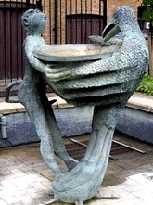 |
Bird and Monkey Fountain. |
|
In the courtyard behind the old West Ham Town Hall. There is a second unnamed carved animal figure with a porcine snout in the same courtyard, but the latter has no accompanying notice giving its name or that of the sculptor. (See No. 3. on the MAP ) Sculptress: Judith Cowan Date; 1986. |
||
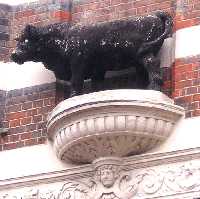 |
Ye Olde Black Bull. |
|
Stratford High Street on the corner of Chant Street. This bull is high up on the frontage and is used as an inn sign. (See No. 4. on the MAP ) Date: 1892. |
||
 |
Boundary Marker. |
|
Stratford Park. This marker was set up by the Carpenters Company, whose arms are displayed on it. It appears to be a boundary mark. The Carpenters Company originally owned much land in Stratford. This is commemorated by a pub called the Carpenter's Arms situated in Carpenters Road. Other Boundary markers of City Companies see Ironmongers and the Mercers Company. (See No. 5. on the MAP ) |
||
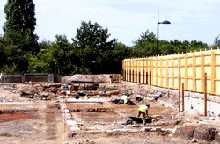 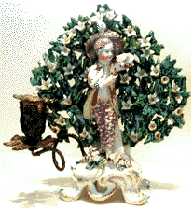 |
Bow China Factory. |
|
Part of the pottery lay under the apartments known as Central House 32-36 High Street. This is north east of the Bow flyover before you get to Marshgate Lane. In August 2006, the site was being cleared for further development and archaeologists were recording the foundations of buildings on the site, when this photo was taken. This factory played a big role in the history of English porcelain. In 1744, Thomas Frye (1710-1762) and Edward Heyleyn patented a method of producing china of equal quality to that imported from the Chinese. The factory was sometimes known as "New Canton". The 18th century candle holder is an example of the pottery produced on this site and is on show at the Geffrye Museum in Shoreditch in the Overview section for Rooms 5, 6 & 7. (See No. 6. on the MAP ) |
||
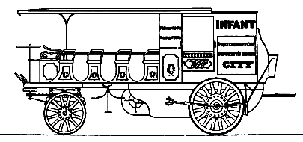 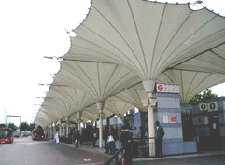 |
First Bus To Brighton. |
|
From 1824 Walter Hancock began experimenting with steam-driven road transport. His workshop was probably south of the Stratford High Street by his house in Turnpike Row (not far southwest of No. 2. on the MAP ) He made several different vehicles gradually making improvements. In 1832 he felt sufficiently confident to take passengers on a long journey on his steam bus called "The Infant". He set out from Stratford early in the morning travelled to London Bridge at about 5 mph so as not to frighten the horses. He picked up 10 passengers at 6.0 am and set out with a stoker standing precariously on the rear platform. Once out of town he increased speed to 10 or 15 mph and climbed Red Hill with ease. His problem was fuel supplies. The coke supplied in the country was not up to London standards and provided less power. They eventually had to stop at Hazeldean where the passengers stayed the night while a messenger rode off on horse back to arrange for more fuel. The next day they arrived in Brighton and received a great welcome. After parading along the front, they set out for the return journey. They were still only half way on the return leg when a flange on one of the wheels broke due to the rough unmade roads. They had covered more than 70 miles proving that mechanical transport was a practical possibility. For about a month Hancock ran a regular bus service from Stratford to the city. In 1840 high tolls and low speed limits were placed on mechanical vehicles, so little progress was made until the laws were changed more than 50 years later. The present bus station designed by Soji Abass in 1994. When it rains, the water is taken away down the middle of the supporting pillars. (See No. 7. on the MAP ) | ||
 |
Old Court House |
|
Tramway Avenue. This crest is over the door into the Old Court House. This was the crest of the old Stratford Langthorne Abbey. This device was incorporated into the arms of West Ham. (See No. 8. on the MAP ) |
||
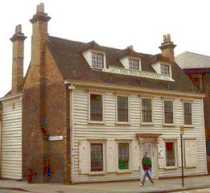 |
The Old Dispensary |
|
This wood clad building on the corner of Romford Road and Mantle Way. As its name implies, it was used in the nineteenth century as a dispensary, but especially for the poor. Dr William Elliot opened the dispensary and Mrs Mary Curtis provided the building and refused to charge rent. This was the beginnings of what later became Queen Mary Hospital. Built originally about 1700, it is now a listed building. (See No. 9. on the MAP ) |
||
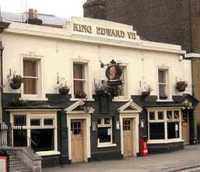 |
King Edward VII |
|
A public house in Stratford Broadway probably dating from at least 1765. It was originally called the King of Prussia perhaps after Frederick the Great (1740-86) or else after King Frederick William IV who visited the borough in 1842, when he called upon Elizabeth Fry, the prison reformer. In 1917, during the first world war, the British royal family dropped their German surname and became the house of Windsor, they were following a trend set by this pub which in 1914 had changed it's name to King Edward VII. The pub has an air of antiquity about it and some of its furniture and fittings appear do date from its Prussian period, while parts of the building may date back to the 18th century. (See No. 10. on the MAP ) |
||
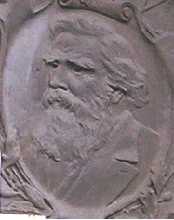 |
Passmore Edwards |
|
On the front of the Passmore Edwards Museum, Romford Road. John Passmore Edwards (1823-1911) was a self-made man who made his money through first writing for and then owning newspapers. He used his wealth for providing communal amenities like hospitals and public libraries. This museum had a varied collection and aimed to provide a spur to further study. Sadly it was allowed to close, and the collection was dispersed. (See No. 11. on the MAP INLAY ) Sculptor: Henry C Fehr. Date; 1900. |
||
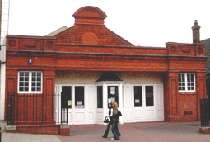 |
The Grove Picture Palace. |
|
121 The Grove, Stratford. This building has had a varied career. In 1910, it became the Grove Picture Palace and was thus one of the very early cinemas, The old ticket office was kind of kiosk which can still be seen projecting forward from the centre of the front. The building was later used as a Billiard Hall and is now a Doctors' surgery (See No. 12. on the MAP ) |
||
 |
Gurney Monument. |
|
On the central island in the Broadway, by The churchyard of St John's Church and opposite the old Town Hall. Samuel Gurney (1786 – 1856) was resident of West Ham and a prominent Quaker. He supported his sister Elizabeth Fry in her work to improve prison conditions, he played an important role in securing the emancipation of black slaves and campaigned to abolish the death penalty. He also was largely responsible for founding the Metropolitan Drinking Fountain and Cattle Trough Association, which flourished in the 19th century and many of their troughs still survive today. (See No. 13. on the MAP ) |
||
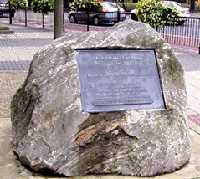 |
Gerard Manley Hopkins. |
|
The Grove, Stratford, outside the Library. The poet, Gerard Manley Hopkins (1844-1889) was born at 87 The Grove.
Hopkins became a Roman Catholic priest and taught at Stoneyhurst School. His poems were published posthumously by his friend Robert Bridges. On the monument are four lines from his "The Wreck of the Deutchland":
|
||
  |
Ironmongers Stone. |
|
On the west side of Leather Gardens. This small stone is by the side of Brassett Point behind a row of garages. It is a border stone marking the edge of the property once belonging to the Ironmongers' Company. This was one of the City Companies and was granted a coat of arms in 1455. It is this coat of arms which is shown on the stone. At present (2007), this stone is within a construction site. Once the building is completed, it is hoped that it will be more easily accessible. See also the landmarks of the Carpenters Company and the Mercers' Company.) For the position of the stone (See No. 15. on the MAP ) The Webmaster would like to thank Robert Rogers for drawing his attention to this site and for furnishing information. |
||
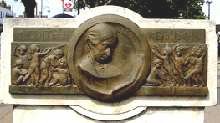 |
Edith Kerrison. |
|
Outside the Public Library, The Grove. A memorial to the memory of Edith S. Kerrison (1850-1934), who was the first woman to serve on the West Ham council. She took a great interest in the welfare of women and children. In 1936 she was made an Honorary Freeman (sic). There is also a small inscription near the base saying that this monument is placed in a garden. The garden used to be on the corner where The Grove met Romford Road. Sadly it has been replaced by a Hotel and restaurant, and the only vegetation poor Edith Kerrison now has are one or two stray trees stuck in holes in the pavement. It is doubly sad because the garden was the only greenery left on what used to be Stratford Green. (See No. 16. on the MAP ) Sculptress: Christine Gregory Date; 1936. (See also "Spring" by the same artist.) |
||
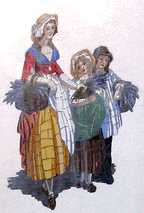 |
The Lavender Sellers. |
|
A mosaic of large tiles on the wall of Warton House, 150 High Street, E. 15. The Building was previously occupied by Yardley's who used this as a trade mark. It is odd that a perfumer and soap maker should have chosen to place his offices here, because a few years before the bridge just down the road, which was replaced by the Bow flyover, was often referred to as "Stinkhouse Bridge". This was due to the stench produced by chemical works and a neighbouring factory making glue from the bones collected by rag and bone men. In 1648 a previous Bow Bridge had witnessed a minor skirmish in the civil war. In that year Lord Norwich a cavalier commander, who had been defeated in Kent, crossed the Thames at Blackwall and clashed with parliamentary forces and had to retreat to Colchester. The design was adapted from the Primrose Sellers, one of a set illustrating the Cries of London, produced 1792-1796. The full title was originally: "Two Bunches a penny, Primroses, Two Bunches a penny." (See No. 17. on the MAP ) Original Painter: F. Wheatley. |
||
 |
"Millennium Mural." |
|
On the corner of the Broadway and Great Eastern Road, on the side wall of Wetherspoons. The photo, which is a detail from the large mural shows an artist's impression of Wiggen Mill. This mill dating from at least the 12th century, stood on the Channelsea river and was a tidal mill. It belonged to Stratford Longthorne Abbey. The rest of the mural shows buildings and events in Stratford during the last 1000 years. (See No. 18. on the MAP.) |
||
 |
"The Peace Sculpture." |
|
Now outside Morrison's in Stratford, but originally placed in a garden near the Romford Road corner. The statue was commissioned by the London Borough of Newham to commemorate the international year of peace in 1984. If one looks carefully, one see that what at first looks like beach ball, is in fact the globe of the earth which the three figures are together supporting. Destroying any one would cause the world to fall. (See No. 19. on the MAP ) Sculptor: Derrick Richardson-Lee (1924-2001) |
||
 |
Protestant Martyrs Memorial. |
|
In the churchyard of St John's Church, Stratford Broadway, E15. Erected in 1878 to remember the eleven Protestant martyrs who died during the reign of Queen Mary and who met their death on June 27th, 1556. These people were burnt at the stake on Stratford Green before a large crowd of onlookers. Stratford Green or Common used to stretch from here down Romford Road to about where the University of East London now is. (See No. 20. on the MAP ) Architect: John Thomas Newman. |
||
 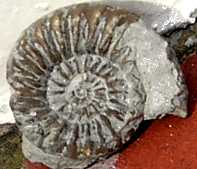 |
Centrifugal Pump. |
|
By the side of the Greenway footpath just East of the Abbey Lane Pumping Station. This was used for pumping and separating the sewage. It would make a fine modern sculpture if it was not for all the graffiti. The design of this piece of 20th century technology seems to have been influenced by the shape of a Jurassic Ammonite c. 170 million years BCE as shown on the right. (See No. 21. on the MAP ) |
||
 |
"Railway Tree" |
|
This stands at the junction of the Broadway and Great Eastern Road, Stratford, E15. This structure is aligned by the compass points. The steel girders are shaped like railway lines and are intended to remind us of the area's past connection with industry and the railways. Stratford station opened in 1839 together with engineering workshops of the Eastern Counties Railway. This later became the Great Eastern Railway, and their workshops built 1,682 steam locomotives between 1850 and the 1920s. At one time the railway yards and the repair depot employed 3000 workers. With the construction of the new international railway connection, this sculpture has become even more relevant. (See No. 22. on the MAP ) Sculptor: Malcolm Robertson. Date: 1996. (See also "Time Spiral" by the same artist) |
||
 |
"Robert" |
|
Tank engine. Great Eastern Road, E15. Outside Stratford Station. This is the Avonside 0-6-0 Engine No. 2068 built in 1933 and named Robert. These engines were mainly used for private industrial purposes. Robert was found at Beckton, and was in a dilapidated state as it had been vandalised. It was repaired, repainted and prepared for public display by having dangerous or breakable parts removed to discourage further acts of vandalism. In 2008 Robert was shunted off to the East Anglian Railway Museum while the £100 million upgrade to Stratford station is being carried out. So the engine will be standing in Chappel & Wakes Colne Station, Essex for three years before it returns to Stratford, hopefully before the 2012 Olympics. (See No. 23. on the MAP ) |
||
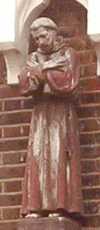 |
St Francis |
|
On the front of the Catholic Church of St. Francis of Assisi run by the Franciscan Order of Friars Minor. This is in The Grove, Stratford. The statue probably dates to 1873 when the Franciscans took over the church and dedicated to St Francis. It had been built five years earlier. Then it had been dedicated to St Vincent de Paul. (See No. 24. on the MAP ) |
||
 |
"Science." |
|
Built in 1898 as West Ham Technical Institute and Museum, is situated at the corner of Romford Road and Water Lane. It has very elaborate decoration on its exterior gable ends. Most figures represent the subjects taught within. This group symbolises "Science and Technology". Others show "Fine Arts", "Literature", "Music" and "Engineering". This area had once been known as Stratford Green. (See No. 25. on the MAP INLAY )
Architects: J.G.S.Gibson and S.B.Russell. 1898. |
||
 |
William Shakespeare |
|
Outside the University of East London at the entrance in Water Lane. The statue is made of Coade stone and originally stood in the Opera House in the Haymarket and dates from about 1840. It was set up here in 1925. (See No. 26. on the MAP INLAY ) Date: c. 1840. |
||
 |
Stratford Common. |
|
In the grounds of the University of East London, just inside the railings at the corner of Water Lane and Romford Road. This block for helping riders to mount their horses formerly stood on Stratford Common. This was an area of land where commoners could graze their animals. It stretched westward from the Broadway along the north side of Romford Road. In 1556, eleven Protestant Martyrs were burned here to make a public spectacle. The words This stone used to stand in Carnarvon Road to mark the boundary of the old Stratford Common.Its present position is still within the old area of the common. (See No. 27. on the MAP INLAY ) |
||
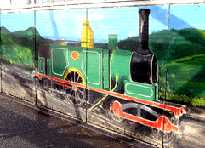 |
Stratford Frieze |
|
On the footbridge between Jupp Road and Station Street over the Jubilee and Silverlink Metro lines. This is a series of pictures of trains and buses over the ages. It was inspired by the important role that Stratford played in this development. (See No. 28. on the MAP ) |
||
 |
Stratford High Street Railings |
|
Situated above the railings in the centre reservation of the dual carriageway of the A11 leading into the one way system from the south. These whimsical figures include a horse with a snail on its head and what looks like a dodo perched on the back of a galloping unicorn. Stratford High Street was set in its present alignment around 1115, when Queen Matilda or Empress Maud as she was sometimes known, commanded commanded that bridges should be built over the 5 channels of the river Lea and that a raised cause way should be built to link them. Before then the road crossed the Lea further north at Old Ford. In 1814, the London Bridge house committee came along and marked one of bridges as being the responsibility of the City of London. Unfortunately they marked the wrong one. As a result St Thomas's Bridge became Pegshole Bridge and vice versa. The mill owners who had previously been responsible for the upkeep of the marked bridge did not complain because they now had a smaller bridge which was cheaper to maintain. (See No. 29. on the MAP ) |
||
 |
Stratford Langthorne Abbey. |
|
The Cistercian Abbey of Stratford Langthorne (meaning Long Thorn) is no longer standing. Founded in 1135 by William de Montfichet who succeeded Robert Gernon as owner of the local manor, the Abbey was an important centre for four centuries. For a brief period in 1267 Henry III made this his headquarters in his struggles with Simon de Montfort. It ceased existence in 1538 in the reign of Henry VIII at the time of the dissolution of the monasteries. However some of the masonry is thought to have been preserved and is now in All Saints Church, West Ham. The stone illustrated shows five skulls, and is thought to have been over the entrance to the Charnel House of the Abbey. There is also a double window frame, but this was under wraps for repairs in 2006-7. The latter did not come directly from the abbey. For some of the stonework was rescued from the ruins of the abbey and was used in building the Adam and Eve public house. Perhaps the monks would have had a slight consolation from the fact that at least the pub had a biblical name. They would have been less happy with one of the curates of this church, William Dodd, who later got into financial difficulties, signed someone else's name on a promissory note, was found guilty of forgery and in 1777 was publicly hanged. (See No. 30. on the MAP ) (See Abbey Mills Pumping Station and also the Abbey Crest) |
||
 |
Stratford Market |
|
Stratford covered Market near the exit to the station. This design covers the lift shaft, which is in front of the entrance to Sainsburys. Sadly, the clock has been out of order for a long period. (See No. 31. on the MAP ) |
||
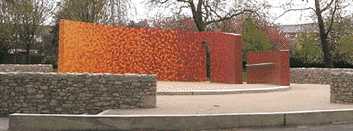 |
Stratford Park |
|
Sculptured bandstand/stage/walk-through sculpture is in Stratford Park. The tiled backing wall centrepiece stands within a large circular area with low walls. (See No. 32. on the MAP ) |
||
 |
Theatre Royal |
|
Gerry Raffles Square. This theatre dates back to 1883. It was of considerable importance after the second World War when Joan Littlewood as director and Gerry Raffles as manager of the Theatre Workshop Company took over the theatre. A number of productions were first tried out here before transferring to the West End. After Raffles died young, the square was named after him. (See No. 33. on the MAP ) |
||
 |
"Time Spiral". |
|
Great Eastern Road, E15. Outside Stratford Station. Made in shiny stainless steel. Like the "Railway Tree" by the same artist, this is intended to show that Stratford is a transport hub from which one can travel in many directions. Round the base of the clock the symbols for the signs of the Zodiac are arranged in a circle. Strangely, there are only eleven as someone has crudely removed one and it has been replaced by a metal plate. This clock is sited on the Greenwich meridian line. (See No. 34. on the MAP ) Artist: Malcolm Robertson. Date: 1996.. |
||
 |
The Old Town Hall. |
|
Stratford Broadway, E15. Some of the many sculptures on decorating the skyline of the old town hall in the Italian style. The two highest figures are Britannia and St George. The lower ones represent Science, Art, Commerce, Agriculture, Industry, Justice, Mercy, Prudence and Temperance. The latter was obviously necessary to glare down on the patrons of the various pubs on the Broadway below. (See No. 35. on the MAP ) Sculptor: Mr Bromfield of Kensington. 1868. |
||
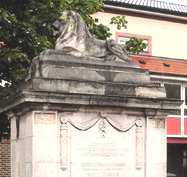 |
The War Memorial Mystery. |
|
At the junction of Abbey Road and Mitre Road. The first name listed amongst the dead of World War 1 is that of Comte Robert de Lesseps, Legion d'honeur and Croix de Guerre. Robert was the son of Ferdinand, Vicomte de Lesseps, the man responsible for digging the Suez Canal and Robert was also the great-nephew of Empress Eugenie, wife of Napoleon III. The memorial is not a municipal one but that of the Crocketts' Leather-cloth factory, which used to be sited here. Robert died in 1916 and had been an early pioneer aviator and friend of Bleriot. But why should Crocketts wish to remember him in this way? (See No. 36. on the MAP ) |
||
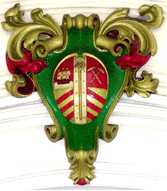 |
West Ham Coat of Arms. |
|
Over the Romford Road entrance to the University of East London. There are three sections. The lower half represents Stratford as these chevrons were the crest of Stratford Langthorne Abbey. The top right are the crossed hammers of the Thames Iron Works representing ship-building and later used by West Ham United Football Club and the ship represents the docks to the South. (See No. 37. on the MAP INLAY ) |
||
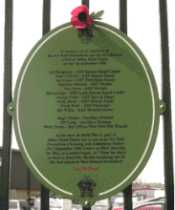 |
West Ham's First Casualties. |
|
By the front gate of the Bridge Road Depot, which is in fact in Abbey Road. The memorial notice lists the names of 13 members of the ARP (Air Raid Precautions) and the fire service who were killed here. The notice states:
(For the memorial see No. 38. on the MAP ) |
||
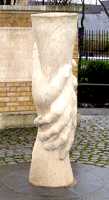 |
Workers' Memorial. |
|
Situated on Three Mills Green, entry from Bisson Road. The inscription says: Of your charity pray for the souls of Thomas Pickett, Godfrey Maule Nicholson, Frederick Eliott and Robert Underhill, who lost their lives in a well beneath this spot on 12 July 1901. The first named while in the execution of his duty was overcome by foul air. The three latter successively descending in heroic efforts to save their comrades shared the same death… This monument was erected in 2001 to replace the original which was 150 metres to the south. The statue shows one arm grasping another in a rescue attempt. Bisson Road is named after Daniel Bisson who built the House Mill in 1776. (For the memorial see No. 39. on the MAP ) |
||
OTHER AREAS COVERED:-
|| Beckton || Bethnal Green || Blackwall || Bow || Bromley-by-Bow || Canary Wharf || Canning Town || Chingford || Cubit Town || Custom House || East Ham || East India Dock || Forest Gate || Higham's Park || Leyton || Leytonstone || Limehouse || Little Ilford || Manor Park || Mile End || Millwall || North Woolwich || Plaistow || Plashet || Poplar || St George's || St Katharine Dock || Shadwell || Shoreditch || Silvertown || Snaresbrook || Spitalfields || Stepney || Upton || Walthamstow East || Walthamstow Village || Walthamstow West || Wanstead || Wapping || West India Dock || Whitechapel || Woodford || |

 are carved into the stone in Gothic script. A later notice has been added saying:
are carved into the stone in Gothic script. A later notice has been added saying: